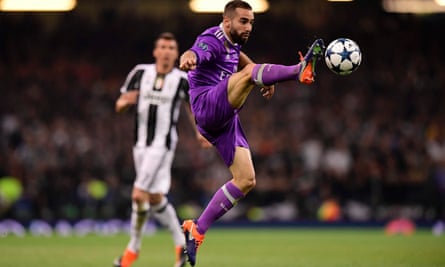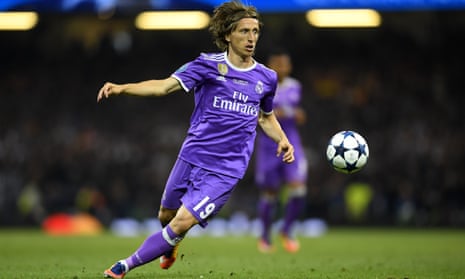The key feature of the opening stages of the Champions League final on Saturday was Real Madrid suffering down their right flank. Luka Modric was forced to cover a huge amount of space, and the right-back Dani Carvajal was overloaded and overpowered by Mario Mandzukic. By the end of the night, however, Real ran out comfortable winners – with Modric and Carvajal crucial in their attacking play.
It is rare to see a European final contested between two teams using such flexible systems. Zinedine Zidane’s use of Isco rather than a half‑fit Gareth Bale meant Real set out in a fluid 4-4-2, with Isco popping up on both flanks and drifting around the pitch, essentially given a free role to ensure Real dominated possession.
Max Allegri’s Juventus system is designed to move between a three- and four-man defence fluidly, with Dani Alves pushing forward from wing-back and Andrea Barzagli pushing wider when necessary. But this looked like a fairly standard 4-2-3-1 system, albeit with Alves and Mandzukic as the two wide players – one a converted full-back, the other a converted centre-forward.
Indeed, for long periods of the first half Juventus’s shape was excellent. They were extremely compact and pressed effectively in midfield positions, with Gonzalo Higuaín and Paulo Dybala dropping back in an attempt to crowd out Real Madrid in central zones. The Italian champions started brightly, and often exploited Real’s lack of a right‑sided midfielder by knocking passes out to the Juve left-back Alex Sandro, who brought the ball forward on the outside of Modric.

However, Juve’s attacking play was somewhat rudimentary. They focused heavily on hitting long diagonal balls for the 6ft 3in Mandzukic, trying to exploit his obvious height advantage over the 5ft 8in Carvajal. He often won these aerial battles, but this did not create any significant chances. Indeed, for all Juve’s early pressure, it is arguable that they did not create a single presentable opportunity all night, finding the net only through Mandzukic’s truly extraordinary overhead kick. Aside from that, two Miralem Pjanic efforts from outside the box were all they offered.
Real steadily grew into the game, and their defensive shape improved. In the opening stages, their four midfielders were very narrow, opening up space down the flanks for Juventus, but they switched to more of a flat four‑man midfield without possession and protected their defence more effectively. Gradually, Real started to show their superiority in possession too. Isco’s movement caused problems, but the positioning of Modric and Toni Kroos was crucial – they drifted into slightly wider areas to receive the ball away from Juventus’ compact press, and started dictating play with intelligent, measured passes. Modric was particularly outstanding, slaloming away from challenges in the first half and then showing his excellent possession play later on when the game opened up.
Carvajal, too, enjoyed an excellent game. While Mandzukic was able to exploit his lack of height, the right-back took advantage of his superior pace by continually speeding forward on the overlap. This played a significant part in Real’s opener, when he showed a sudden burst of speed before laying the ball back for Cristiano Ronaldo to fire home. Real’s second goal was fortunate, Casemiro’s hopeful long-range shot taking a wicked deflection off Sami Khedira and spinning past Gianluigi Buffon, but the third goal was another example of Real’s good play down the right, with Carvajal and Modric combining, before the Croatian crossed for another Ronaldo finish from that inside-right position, this time from close range.
Juventus offered little discernible plan B. Indeed, their substitute most likely to change the game, right-winger Juan Cuadrado, endured a nightmare cameo appearance and was sent off, which opened up space for the Real left-back Marcelo to drive forward and assist Marco Asensio for Real’s fourth. Much like their 4-1 win against Atlético Madrid in the 2014 final, the margin of victory was a harsh reflection on their opponents’ efforts. But Real and Ronaldo have a handy knack of producing at decisive moments.
